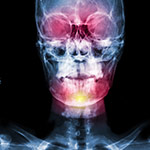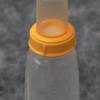The most important problem of children with cleft lip or palate, which must immediately be resolved, is the feeding, so as to ensure the intake of a sufficient quantity of food. Babies with cleft palate may initially experience difficulties in breastfeeding, as it lacks the physical separation between the nose and mouth. This creates difficulties in infants, which in trying to feed swallow air, causing excessive belching or even vomiting.
The initial difficulties in feeding are easy to overcome. The techniques of new-borns' feeding are something that all parents get easily familiar with and soon discover with relief that the baby gains weight satisfactorily.
IF THE NEWBORN BREASTFEEDS
- The nipple and the areola may clog the vacuum in the cleft, thus facilitating the milk’s intake.
- The exercise with slight pressure with the fingers in the area of the areola can help milk flow.
- The preliminary kneading of the breast facilitates the milk’s accumulation in the area of the nipple and allows it to run easily.
- If difficulties persist, it may be preferable to pump the milk with a breast pump and give it to the baby with bottle.
IN THE CASES WHERE THE NEWBORN IS FEEDING WITH BOTTLE
- The nipple that is going to be used should be soft.
- We do not recommend the use of special nipples for cleft palate that are available in the market, because they are bulky and are hardly tolerated by the infant. We recommend instead, rubber nipples, which soften with prolonged boiling.
- Carving criss-cross the nipple with a pair of scissors, growing the opening and it is facilitated the flow of the milk or formula.
- It is further recommended to use plastic baby bottles that can be compressed, thereby increasing the flow.
- Finally, if all the above mentioned prove insufficient, specially designed baby bottles may be used, such as the baby bottle HABERMAN (available in Greece. Usage shown on a special film on YOUTUBE), or the baby bottle MEAD JOHNSON (that you can only procure online).
- The baby bottles do not require sterilization after each use. Washing with warm water and soap is enough.
PLEASE NOTE WITH REGARDS TO THE FEEDING OF THE NEWBORN
The feeding of new-borns with cleft palate (and cleft lip) differs in some points from the usual new-borns' feeding.
- The infants with cleft intake less quantity per meal, but they need more frequent meals.
- During feeding, the infant should be held in an upright position in order to facilitate swallowing.
- If the baby sneezes during feeding and throws milk from the nose, this does not mean that he/she is drowning. Simply, wipe the nose with a clean handkerchief.
- The meal should not take more than 30 minutes. If it lasts longer, it is an indication of overexertion on his/her part and the technique should be adapted.
- After each meal you must have the infant upright and with slightly heeltaps to the back help him/her to burp.
Indication of sufficient food intake is the normal weight gain. If he/she is not gaining weight properly, certain adjustments should be made in consultation with your pediatrician.



